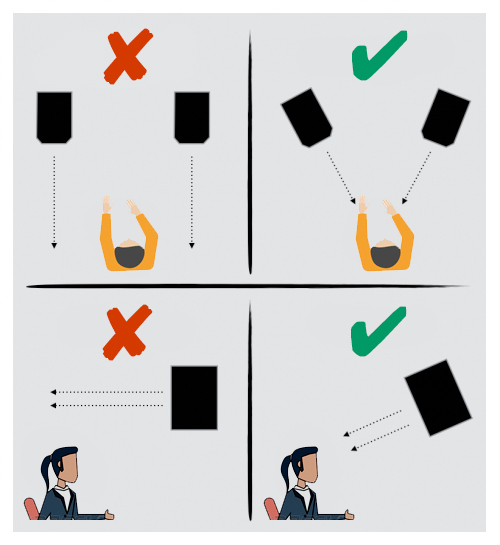Our guides
To choose well
How to choose your monitoring speakers?
To create your music, you will obviously need a listening system: headphones and/or speakers. Although the headphones are an excellent tool in your mixing phases, you will need to complete it with monitoring speakers to have a comparative listening. We will see through this guide what are the different characteristics to remember in order to guide you in your purchase of monitoring speakers.
Monitor speakers
For your studio or your home studio, the choice of speakers will be essential. Indeed, the monitoring speakers are at the end of the sound chain (example: you record a guitar, process it on your software, then listen to it on your speaker). For continuity, the quality of the sound you hear will depend on the quality of your monitoring pair. With a bad listening pair, you won't be able to hear the details of your composition or recording (even if they're good). It will be wise to start with a good pair of speakers from the start, because it is one of the elements of your Home Studio that really lasts over time. Moreover, by dint of listening, you will know them by heart!
Monitoring speakers generally consist of a woofer and at least one tweeter. They connect to a sound card via a jack, XLR, sometimes RCA and cinch output (red and white Hifi sockets).
Monitoring vs. hi fi
What is the difference between Hifi speakers and studio monitors?Do not confuse monitoring speakers (also called "monitors") with Hifi speakers (High-Fidelity). Indeed, the monitoring speakers want to be as neutral and faithful as possible, ie without sound coloration, reproducing the recorded sound as well as possible. The Hifi speakers will embellish, enrich the sound emitted in such a way as to make it more pleasant for the listener, and this is not what we are looking for in the context of a Home Studio.
For what uses?
The monitoring speakers will therefore be used as a listening work tool and will have to reproduce the sound closest to the reality of the frequencies of the music broadcast. Thanks to them, you will be able to:
- better distinguish each instrument in the mix
- hear and correct any volume or frequency equalization faults
- avoid unpleasant surprises when you listen to your music on a new medium
How to choose ?
To choose your pair of proximity listening, we are going to list the main characteristics which vary according to the brands and models.
The frequency response
The purpose of your monitoring speakers is to facilitate the mixing of your tracks by reproducing your music as faithfully as possible. The entire audible frequency spectrum lies between 20Hz and 20000 KHz. The speaker's frequency response will tell you the frequency range over which the sound should be flat, or nearly so. Indeed, it is impossible to have a totally flat frequency response curve, even if some loudspeaker models come close to it. If you see, for example, on the characteristics of a speaker 38 Hz -22,000 HZ, this indicates that in this frequency interval the sound is "flat".
It will be preferable to have a pair of monitoring speakers going down to at least 50HZ, otherwise you will encounter listening and mixing problems in the low frequencies. The lower your speaker goes, the clearer and more detailed the lower end of the spectrum will be, which is very useful especially for electronic music. However, if your speakers don't go as low as you'd hoped, you can always get a Subwoofer (subwoofer) provided your room is well treated, in which case it will make your rendering even more incomprehensible.
Speaker size and power
In the family of studio monitors, size is not necessarily synonymous with quality. If loudspeakers with a large woofer most of the time allow access to lower frequencies, these can be counterproductive in a small room. The high power of the speakers will go against the desired effect in a room that is too small and you will lose precision. The power and therefore the size of your speakers are therefore above all a question of volume which will affect performance.
There are usually 3 sizes of speakers: 5", 6.5" & 7" and finally 8".
If you are in a small space, we advise you to buy 5-inch or 6.5-inch models and to favor two-way speakers, even if it means using headphones for the low frequencies. There is no need to equip yourself with speakers that are too powerful if you make your music in an apartment, you will not be able to put your speakers loud enough to obtain correct and precise sound, without shaking the whole neighborhood.
In a large room, a model with an 8-inch speaker or more is in its best interest, otherwise the loudspeaker will operate underpowered and the distance between the listening point and the loudspeakers will be too small. . If you can't turn the volume up to a certain listening level, the frequency response won't be optimal.
If your room is not acoustically treated correctly (which is the case for many Home Studios), filter and equalization settings are available on certain speaker models to correct any problems. Some loudspeakers, notably Genelec, are adjustable via software (and a microphone) in order to directly correct the frequency response curve of the loudspeaker, depending on the room.
Active or passive speakers?
There are two categories of loudspeakers: active loudspeakers and passive loudspeakers. Passive speakers require an amplifier while active speakers are monitors with built-in amplifiers.
Sound level, there is no big difference. For a Home Studio, it will nevertheless be preferable to opt for active speakers, with integrated amplification, which will be much more practical. Indeed, with active monitors, you no longer have to worry about the power or the place of the amplifier in your home studio. You will have simplified use: power them on 220V, plug them into your audio interface, and you're done. The volume of each loudspeaker is adjusted directly on the panel on the back of the loudspeaker. On a lot of active monitoring speakers, there are often various additional settings such as a filter or EQs.
Placement of speakers in your Home Studio
The placement of the monitoring loudspeakers and the layout and acoustics of the broadcasting room are crucial for restoring a good listening experience. Indeed, the way your speakers will sound in the low frequencies will be influenced in large part by the size and shape of the room in which you will create and listen to your music, but also by their positioning. The mid and high frequencies, on the other hand, will be similarly influenced by the materials that will be present in your room and on the walls, absorbing the sound.
Another important detail is the distance of your speakers from the wall. If you have to stick your monitors to the wall (practical for small spaces), opt for canopies on the front, or on the side like FOCAL's Shape series, rather than on the back of the monitor to avoid unpleasant disturbances in the bass due to the bad diffusion of the waves (what is called the rumble).
There are three main types of monitoring loudspeakers: proximity loudspeakers, midfield loudspeakers (medium distances) and loudspeakers for main listening. As part of a Home Studio, you will need nearby speakers.
For the placement of your studio loudspeakers, they must be installed symmetrically with respect to the center of the room and ideally be located more than 30 cm from walls and corners. This placement of the loudspeakers is recommended for bass-reflex models with vents located at the back or on the sides. Some monitor models offer a switch to help you adjust the low frequency response to compensate for placement near a wall or at an angle.
In order to have the best listening possible, your speakers and your ears must form an equilateral triangle, that is to say that there is the same distance between each speaker and your ears. It is also necessary that the tweeters are aligned with your ears.

The budget for speakers
The price range varies depending on the type of speakers:
- The first price speakers are between 50 and 150€ and are more of a hi-fi or multimedia listening speaker.
- Mid-range speakers between €150 and €450 each offer very good value for money.
- Top-of-the-range speakers range from €450 to over €7,000 for models of excellence.
Keep in mind that you won't regret investing in good speakers that will be essential parts of your home studio.
Monitoring accessories
In order to best optimize your listening, it will be necessary to plan the purchase of useful accessories for the placement of your loudspeaker and the acoustic insulation of your room. Indeed, it is not recommended to place your speakers directly on your studio furniture. It will then be necessary to place them on foam or suitable speaker supports in order to avoid vibrations of the speakers on the furniture. It is very difficult and very expensive to obtain perfect acoustics in your room, but a few acoustic foams placed in the right places can improve your listening conditions.
The connections you have are not necessarily standard and some speakers only offer a few connectors. It's up to you to check what you have, and if necessary, provide adapters and other cables necessary for connecting the speakers: XLR or TRS Jack cables for a balanced connection, or RCA for an unbalanced connection. It is preferable to go directly to quality cables.
Questions ?
You now have all the basics you need to get started and choose your monitoring speakers. It is obvious that everything is not summarized in this guide and you may have some questions or wish to have additional advice concerning the choice of your studio loudspeakers. The Star's Music team is at your disposal to guide you in our stores or by phone 01 81 930 900.


